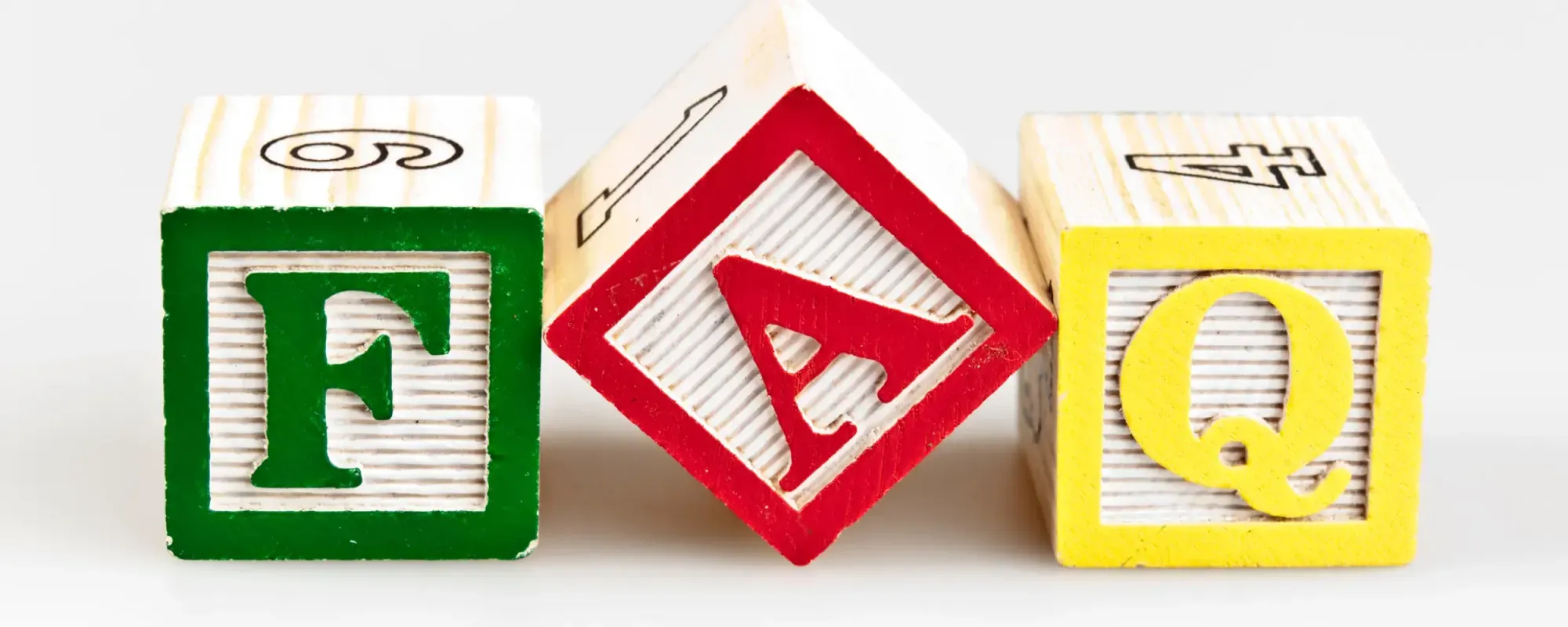Tamil New Year, known as Puthandu or Puthuvarusham, is a vibrant and culturally significant festival celebrated by the Tamil community worldwide. It marks the beginning of the Tamil calendar year and is observed with great enthusiasm and fervor. Puthandu not only signifies the arrival of spring and the onset of a new agricultural season but also embodies the spirit of renewal, hope, and prosperity.
Puthandu Vazthukal meaning

Puthandu Vazthukal meaning deep color fulla traditional Tamil New Year greeting exchanged
"Puthandu Vazthukal" is a traditional Tamil New Year greeting exchanged by Tamil-speaking people around the world during the auspicious occasion of Puthandu. In this article, we delve deeper into the meaning and significance of "Puthandu Vazthukal" and explore its cultural and social importance in Tamil society.
Understanding "Puthandu Vazthukal": "Puthandu Vazthukal" is a phrase in the Tamil language that translates to "New Year Greetings" in English. It is a warm and heartfelt expression of good wishes and blessings exchanged among family members, friends, and acquaintances during the Tamil New Year celebrations.
The phrase "Puthandu Vazthukal" is composed of two key components: "Puthandu" and "Vazthukal." "Puthandu" refers to the Ancient Festival of India New Year, which marks the beginning of the Tamil calendar year and is celebrated with great enthusiasm and joy. "Vazthukal" is derived from the Tamil word "Vazthukal," which means "wishes" or "greetings."
Significance of "Puthandu Vazthukal": "Puthandu Vazthukal" holds significant cultural and social importance in Tamil society. It is not merely a formality but a sincere expression of goodwill, happiness, and prosperity for the recipient's well-being in the coming year. By exchanging "Puthandu Vazthukal," individuals convey their heartfelt wishes for a year filled with success, health, joy, and abundance.
The exchange of "Puthandu Vazthukal" fosters a sense of unity, harmony, and togetherness among Tamil families and communities. It strengthens social bonds and reinforces the values of love, compassion, and solidarity that are intrinsic to Tamil culture. Moreover, "Puthandu Vazthukal" transcends linguistic and geographical boundaries, serving as a unifying force that connects Tamil-speaking people across the globe.
Cultural Practices Associated with "Puthandu Vazthukal": During the Puthandu celebrations, individuals greet each other with "Puthandu Vazthukal" while exchanging visits, gifts, and sweets. It is a time for families to come together, reconcile differences, and renew relationships. Elders bless younger members of the family, imparting wisdom and guidance for the year ahead. Friends and neighbors also exchange "Puthandu Vazthukal" as a gesture of friendship and goodwill.
In the digital age, the exchange of "Puthandu Vazthukal" has extended to virtual platforms, such as social media, messaging apps, and email. Tamil diaspora communities around the world use these platforms to connect with their loved ones and convey their heartfelt wishes for the New Year. Despite technological advancements, the essence and spirit of "Puthandu Vazthukal" remain unchanged, reflecting the enduring values of Tamil culture.
Tamil New Year traditions and customs
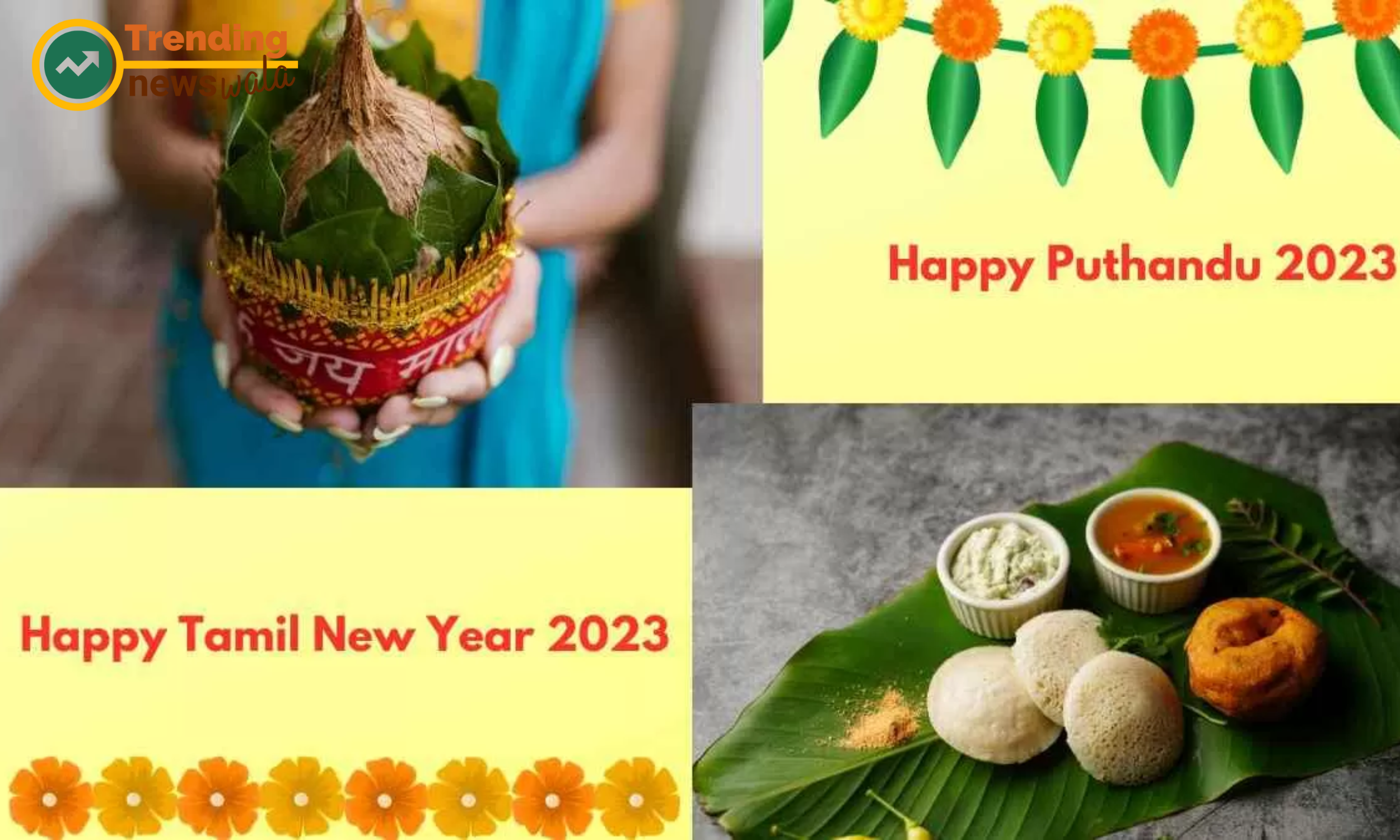
Tamil New Year traditions and customs betel leaves, areca nuts, gold or silver jewelry, coins, flowers, and a mirror.
- The day of Puthandu begins with the traditional "Puthandu Kanni" ritual, where families wake up early in the morning to witness auspicious items arranged beautifully on a tray. These items include fruits like mango, banana, and jackfruit, betel leaves, areca nuts, gold or silver jewelry, coins, flowers, and a mirror. The arrangement is typically placed in front of a deity or in a prominent place in the house.
- The Puthandu Kanni ritual symbolizes the first sight of the New Year, and it is believed to bring good luck, prosperity, and blessings for the year ahead. It is considered auspicious to view the Kanni first thing in the morning, as it sets a positive tone for the rest of the year.
- Kolam, or rangoli, is a traditional decorative art form where intricate patterns and designs are drawn on the ground using rice flour or colored powders. During Puthandu, women decorate the entrance of their homes with vibrant kolam designs to welcome prosperity and happiness into their households.
- Puthandu kolams often feature geometric shapes, floral motifs, and traditional symbols like the sun, moon, and stars. These designs are not only aesthetically pleasing but also hold symbolic significance, representing fertility, auspiciousness, and harmony.
Special Puthandu Cuisine:
- Puthandu celebrations are incomplete without the preparation of special festive dishes that are unique to the occasion. Traditional Tamil delicacies like "Mango Pachadi," a sweet and tangy dish made with raw mangoes, jaggery, and neem flowers, are prepared and enjoyed with family and friends.
- Elaborate feasts featuring a variety of vegetarian dishes are prepared to mark the occasion. Some other popular dishes include Payasam (sweet pudding), Vadai (fried lentil fritters), Sambar (spicy lentil stew), Rasam (flavored soup), and various rice dishes.
Temple Visits and Offerings:
- On Puthandu, devotees visit temples to seek blessings for the New Year. They offer prayers and special offerings to the deities, seeking their divine guidance and protection for the year ahead. Temples are adorned with festive decorations, and special rituals and ceremonies are conducted to mark the auspicious occasion.
- Devotees also participate in spiritual discourses, bhajans (devotional songs), and religious processions organized by temples as part of the Puthandu celebrations. It is believed that offering prayers and seeking the blessings of the divine on Puthandu ensures a year filled with peace, prosperity, and spiritual growth.
Community Gatherings and Cultural Programs:
- Puthandu is not just a family affair but also a time for community gatherings and festivities. Temples, cultural organizations, and Tamil community associations host special events and cultural programs to commemorate the occasion.
- These events feature traditional music, dance performances, dramas, and spiritual discourses that showcase the rich cultural heritage of the Tamil people. It is an opportunity for Tamil families to come together, celebrate their cultural identity, and strengthen social bonds with fellow community members.
Puthandu celebration in Tamil Nadu
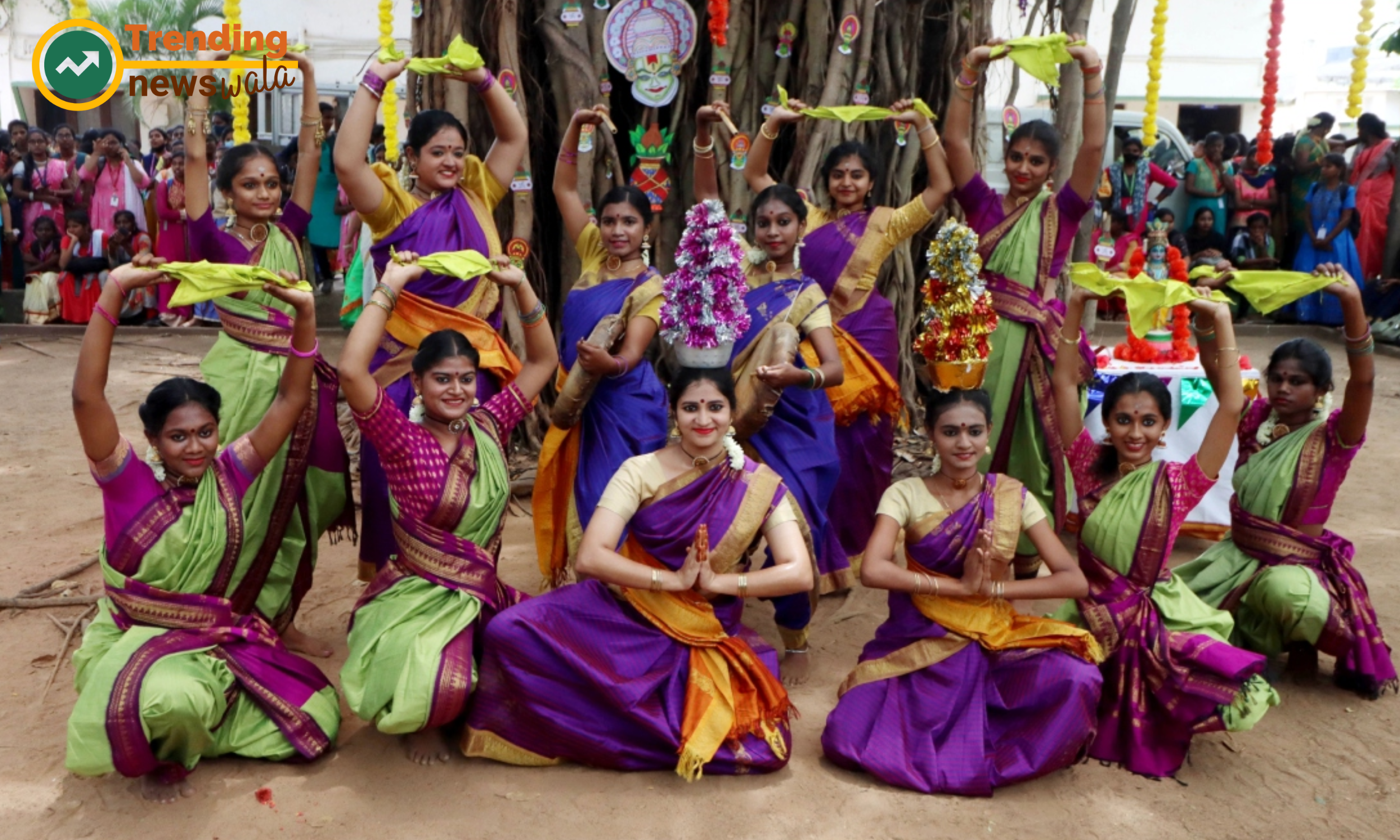
Puthandu celebration in Tamil Nadu Special ingredients are purchased for preparing traditional Puthandu cuisine
Preparation and Anticipation:
- In the days leading up to Puthandu, households in Tamil Nadu buzz with activity as families prepare for the festive occasion. Homes are cleaned and decorated with colorful kolam designs, flowers, and mango leaves. Special ingredients are purchased for preparing traditional Puthandu cuisine, and new clothes are bought for family members to wear on the auspicious day.
- The day of Puthandu begins with the ceremonial "Puthandu Kanni" ritual, where families gather to witness auspicious items arranged on a tray. These items typically include fruits, betel leaves, areca nuts, gold or silver jewelry, coins, flowers, and a mirror. The arrangement is placed in front of a deity or in a prominent place in the house.
- Family members wake up early to view the Puthandu Kanni first thing in the morning, as it is believed to bring good luck and prosperity for the year ahead. The ritual sets a positive tone for the rest of the day's festivities.
Special Puthandu Cuisine:
- Puthandu celebrations are marked by the preparation and consumption of special festive dishes that are unique to the occasion. Traditional Tamil delicacies like "Mango Pachadi," a sweet and tangy dish made with raw mangoes, jaggery, and neem flowers, are prepared and enjoyed with family and friends.
- Elaborate feasts featuring a variety of vegetarian dishes, including Payasam, Vadai, Sambar, Rasam, and various rice dishes, are prepared to mark the occasion. The aroma of these delicacies fills Tamil households, adding to the festive ambiance.
Temple Visits and Offerings:
- Puthandu is a time for spiritual renewal, and devotees flock to temples across Tamil Nadu to seek the blessings of the deities for the New Year. They offer prayers and special offerings, including fruits, flowers, and coconuts, to express gratitude and seek divine guidance for the year ahead.
- Temples are adorned with festive decorations, and special rituals and ceremonies are conducted to mark the auspicious occasion. Devotees participate in religious processions, spiritual discourses, and cultural programs organized by temples as part of the Puthandu celebrations.
Cultural Programs and Community Gatherings:
- Puthandu is not just a religious festival but also a time for community gatherings and festivities. Temples, cultural organizations, and Tamil community associations host special events and cultural programs to commemorate the occasion.
- These events feature traditional music, dance performances, dramas, and spiritual discourses that showcase the rich cultural heritage of Tamil Nadu. It is an opportunity for Tamil families to come together, celebrate their cultural identity, and strengthen social bonds with fellow community members.
Exchanging Puthandu Vazthukal:
- A significant aspect of Puthandu celebrations is the exchange of heartfelt greetings and wishes among family members, friends, and neighbors. The phrase "Puthandu Vazthukal," meaning "New Year Greetings," is commonly exchanged as a gesture of goodwill and blessings for the year ahead.
- People visit each other's homes, exchange gifts, and share festive treats as they extend their warm wishes for happiness, prosperity, and success in the New Year. The exchange of Puthandu Vazthukal strengthens social bonds and fosters a sense of unity and togetherness among Tamil communities.
Significance of Puthandu festival
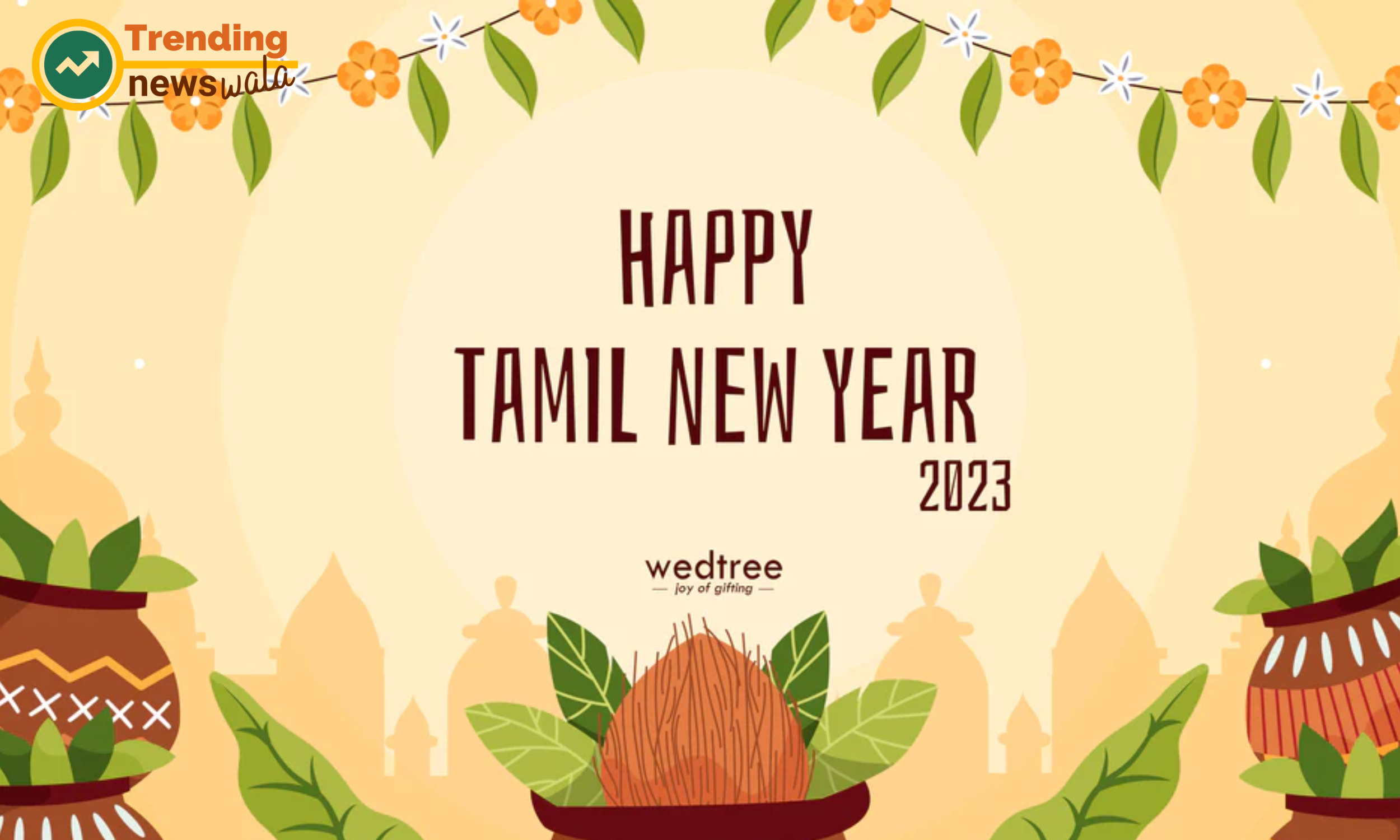
Significance of Puthandu festival offering an opportunity for individuals to reflect on the past year
New Beginnings and Renewal:
- Puthandu marks the beginning of the Tamil calendar year and is celebrated as a time of new beginnings and renewal. It symbolizes the transition from the old to the new, offering an opportunity for individuals to reflect on the past year, let go of negativity, and embrace fresh opportunities and challenges in the year ahead.
Cultural Heritage and Identity:
- Puthandu is an integral part of Tamil culture and heritage, representing the rich traditions, customs, and values that have been passed down through generations. The festival serves as a reminder of Tamil identity and solidarity, fostering a sense of pride and belonging among Tamil-speaking people worldwide.
- Puthandu is also celebrated as a harvest festival, marking the end of the harvest season and the onset of a new agricultural cycle. It is a time to express gratitude to the gods and nature for the bountiful harvest and to pray for favorable weather, abundant crops, and prosperity in the coming year.
- Puthandu holds significant spiritual importance for devotees, who view the festival as an auspicious time for worship, prayer, and seeking divine blessings. Devotees visit temples to offer prayers and special offerings to the deities, seeking their guidance, protection, and blessings for the New Year.
- The festival is also associated with the worship of Lord Vishnu and Lord Brahma, who are believed to be the creators of the universe. Special rituals and ceremonies are conducted in temples to honor these deities and seek their divine blessings for a prosperous and harmonious year ahead.
Community and Togetherness:
- Puthandu is a time for families to come together, reconcile differences, and strengthen bonds of love and friendship. It is a time for joyous celebrations, shared meals, and meaningful gatherings with loved ones. The exchange of greetings, gifts, and festive treats fosters a sense of unity, harmony, and togetherness among Tamil communities worldwide.
- The festival also provides an opportunity for Tamil communities to showcase their cultural heritage and traditions through various events, cultural programs, and festivities. It is a time to celebrate Tamil art, music, dance, literature, and cuisine, further reinforcing cultural identity and pride.
- Puthandu is celebrated with hope and optimism for the future. It is a time to leave behind the trials and tribulations of the past year and embrace the possibilities and opportunities that the New Year brings. The festival instills a sense of positivity, resilience, and determination to overcome challenges and achieve success in all endeavors.
Puthandu special dishes and recipes
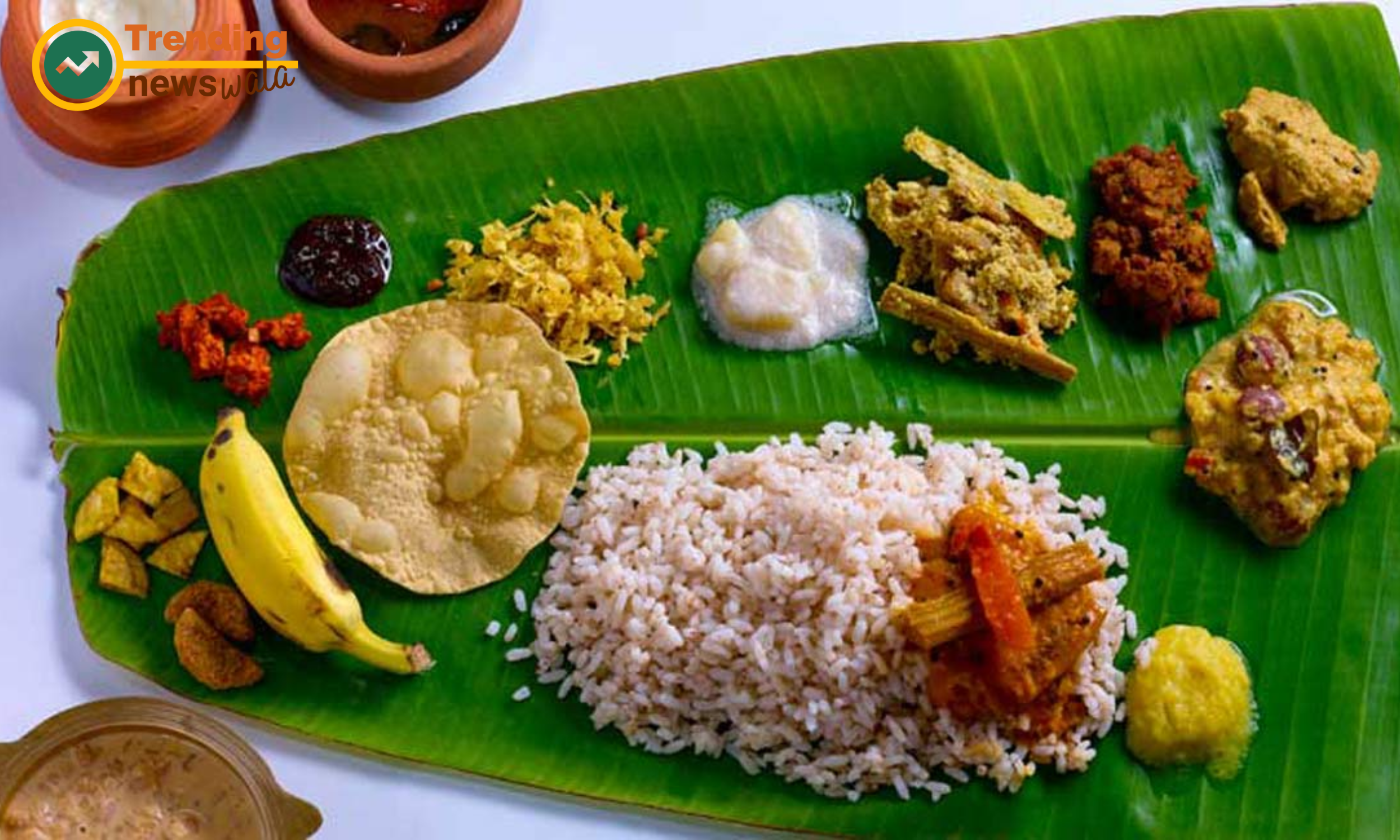
Puthandu special dishes and recipes Mango Pachadi is a quintessential dish prepared during Puthandu celebrations. It is a sweet and tangy dish made with raw mangoes
- Mango Pachadi is a quintessential dish prepared during Puthandu celebrations. It is a sweet and tangy dish made with raw mangoes, jaggery (or sugar), neem flowers, and a hint of spices. The combination of flavors represents the diverse experiences of life, including sweetness, sourness, bitterness, and spiciness, symbolizing the ups and downs one may encounter in the New Year.
- Sambar is a flavorful South Indian lentil stew made with a variety of Coffee table, lentils (usually toor dal), tamarind, and a special blend of spices. For Puthandu, a special version of sambar is prepared using seasonal vegetables like drumsticks, brinjal, pumpkin, and carrots. It is served hot with rice or as an accompaniment to dosa or idli.
- Vadai, also known as medu vadai or ulundu vadai, is a popular South Indian snack made from urad dal (black gram dal) batter. The batter is seasoned with finely chopped onions, green chilies, curry leaves, and spices before being shaped into small rounds and deep-fried until golden brown and crispy. Vadai is enjoyed as a savory snack during Puthandu festivities.
- Payasam, also known as kheer or sweet pudding, is a creamy and indulgent dessert made with milk, rice, sugar, and flavored with cardamom, saffron, and nuts. For Puthandu, special varieties of payasam are prepared, including paal payasam (made with rice and milk), semiya payasam (made with vermicelli), and paruppu payasam (made with lentils).
- Rasam is a tangy and aromatic South Indian soup made with tamarind juice, tomatoes, spices, and herbs like curry leaves, coriander, and cumin. It is light, refreshing, and aids in digestion, making it an ideal accompaniment to a traditional Puthandu feast. Rasam is typically served hot with rice or enjoyed as a soothing drink.
- Puliyodarai, also known as tamarind rice, is a tangy and spicy rice dish that is popularly served during festivals and special occasions like Puthandu. Cooked rice is mixed with a tangy tamarind paste and tempered with mustard seeds, curry leaves, peanuts, and spices. Puliyodarai is flavorful and satisfying, perfect for a festive meal.
- Paruppu Usili is a traditional South Indian side dish made with steamed and crumbled lentils (usually toor dal or chana dal) mixed with finely chopped vegetables like beans, cluster beans (kothavarangai), or plantains. The mixture is seasoned with mustard seeds, curry leaves, and spices, resulting in a nutritious and delicious accompaniment to rice.
- Sakkarai Pongal is a sweet rice pudding made with rice, jaggery, ghee, and flavored with cardamom, cashews, and raisins. It is a popular dish prepared during Puthandu as an offering to deities in temples and also enjoyed as a festive treat at home. Sakkarai Pongal is rich, creamy, and aromatic, making it a delightful indulgence for the taste buds.
Tamil New Year greetings and wishes
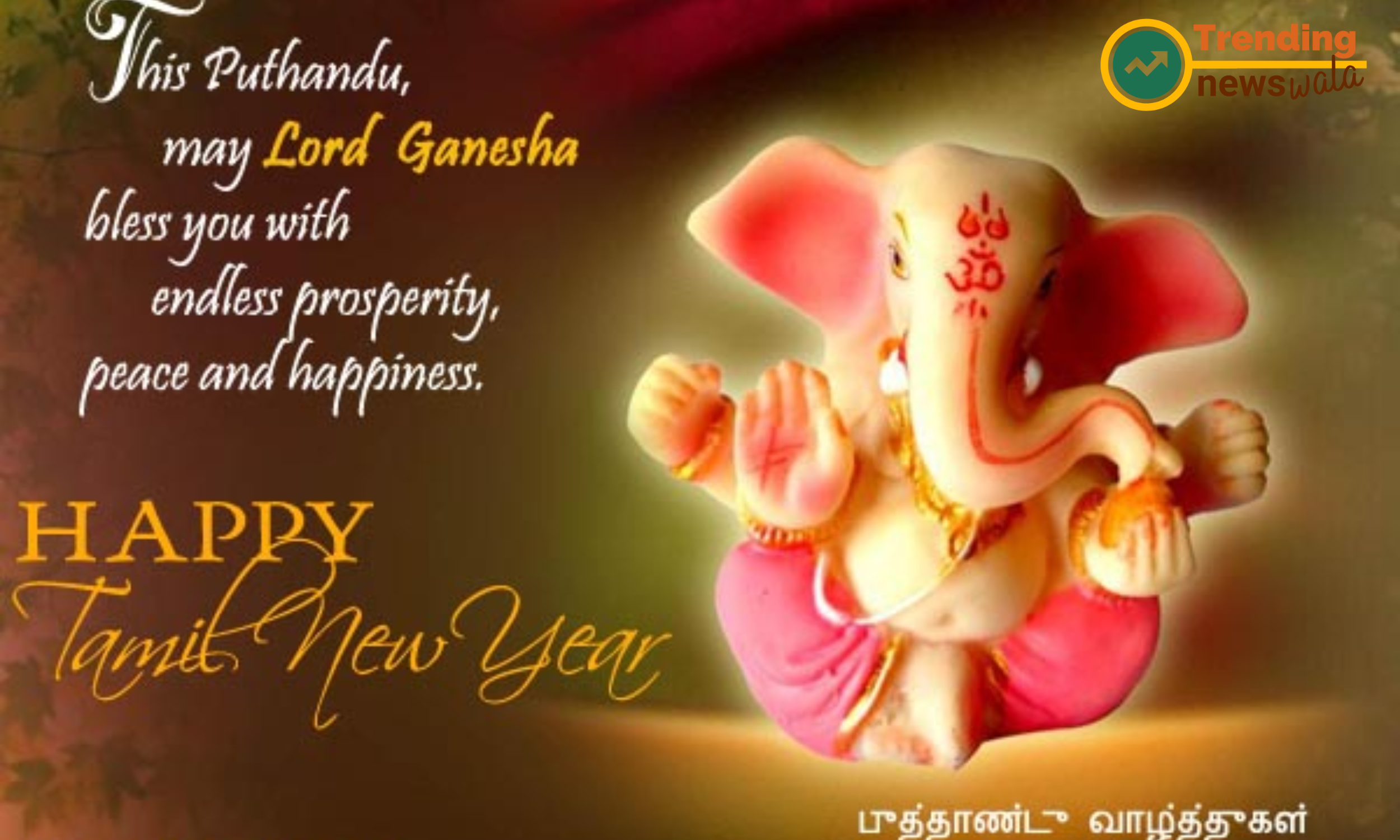
Tamil New Year greetings and wishes It is the most commonly used phrase to convey good wishes and blessings for the New Year.
- "Puthandu Vazthukal" is the traditional Tamil New Year greeting, which translates to "New Year Greetings" in English. It is the most commonly used phrase to convey good wishes and blessings for the New Year. When exchanging Puthandu Vazthukal, people express their hopes for a year filled with happiness, prosperity, success, and good health.
En Iniya Puthandu Nalvazhthukkal:
- Another popular Tamil New Year greeting is "En Iniya Puthandu Nalvazhthukkal," which translates to "My Sweet New Year Wishes" in English. This greeting is often used to convey personal wishes and blessings to loved ones, emphasizing the sweetness and joy of the New Year celebration.
Puthandu Pirappu Nalvazhthukkal:
- "Puthandu Pirappu Nalvazhthukkal" is a formal greeting used to wish someone a happy Tamil New Year. It translates to "New Year Day Greetings" in English and is commonly used in formal or professional settings to convey respectful wishes for the occasion.
Varusha Pirappu Vazthukal:
- "Varusha Pirappu Vazthukal" is another traditional greeting used to wish someone a happy New Year. It translates to "New Year Greetings" and is often accompanied by heartfelt wishes for prosperity, success, and joy in the coming year.
Tamil Puthandu Nalvazhthukkal:
- "Tamil Puthandu Nalvazhthukkal" is a simple yet heartfelt greeting used to wish someone a happy Tamil New Year. It emphasizes the cultural and linguistic identity of the Tamil-speaking community and is often accompanied by warm wishes and blessings for the New Year.
- "Anbu Puthandu Vazthukal" is a greeting that conveys love and affection along with New Year wishes. It translates to "With Love, New Year Greetings" in English and is commonly used to express heartfelt sentiments to family members, close friends, and loved ones.
Puthandu Nalvazhthukkal Ungalukku:
- This greeting translates to "New Year Greetings to You" and is used to wish someone a happy New Year in a respectful and formal manner. It is often accompanied by sincere wishes for happiness, prosperity, and good fortune in the New Year.
- "Puthandu Vaalthukkal" is a warm and simple greeting used to wish someone a prosperous New Year. It translates to "Wishing You a Happy New Year" and is often accompanied by blessings for success, health, and happiness in the coming year.
These Tamil New Year greetings and wishes are expressions of goodwill, love, and hope that reflect the cultural values and traditions of the Tamil-speaking community. Whether exchanged in person, over the phone, or through social media platforms, they serve to strengthen bonds of friendship, family, and community while spreading joy and positivity during the festive season.
Puthandu Kanni ritual
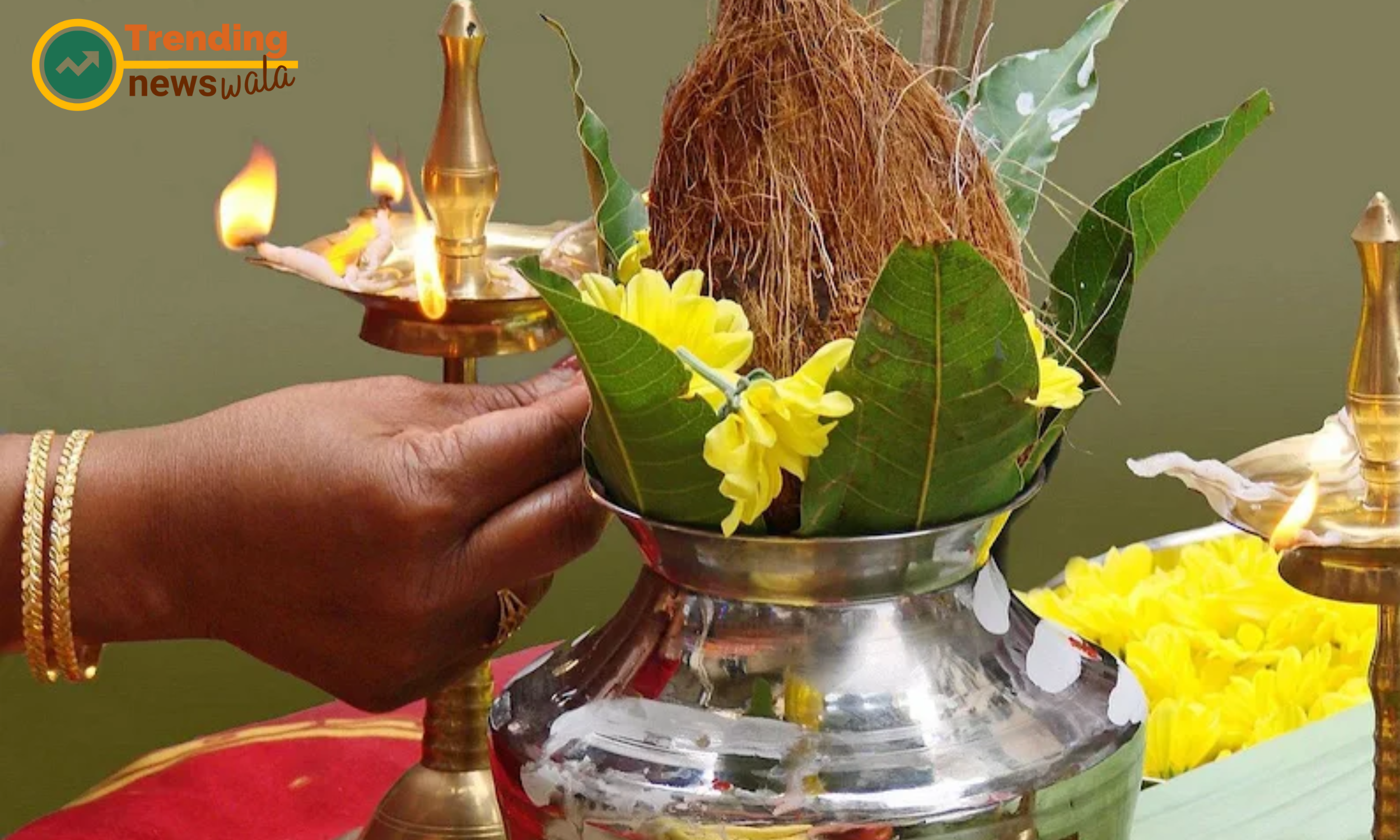
The Puthandu Kanni ritual involves witnessing a carefully arranged display of auspicious items early in the morning
Meaning and Significance:
- The term "Kanni" in Tamil refers to the first sight or vision. The Puthandu Kanni ritual involves witnessing a carefully arranged display of auspicious items early in the morning, which is believed to bring good luck and blessings for the entire year ahead.
- The ritual symbolizes the importance of starting the New Year on a positive note and setting the right intentions for prosperity, success, and well-being.
- The Puthandu Kanni arrangement is meticulously prepared the night before Puthandu. It typically includes a variety of auspicious items such as:
- Fresh fruits like mangoes, bananas, coconuts, and jackfruits, symbolizing abundance and fertility.
- Betel leaves and areca nuts, representing hospitality and auspiciousness.
- Gold or silver jewelry, coins, and currency notes, symbolizing wealth, prosperity, and financial stability.
- Flowers, especially jasmine and marigold, to add fragrance and beauty to the arrangement.
- A mirror, positioned at the center of the display, to reflect the auspicious sight and symbolize self-reflection and inner beauty.
- The arrangement is typically placed on a tray or in a decorated vessel and adorned with traditional decorations like mango leaves and turmeric paste.
Observance of the Ritual:
- On the morning of Puthandu, family members wake up before dawn to witness the Puthandu Kanni. They cleanse themselves and the area where the arrangement is placed to ensure purity and auspiciousness.
- The head of the household, often an elder or the most respected member, leads the family in observing the Puthandu Kanni ritual. They offer prayers and invoke the blessings of the divine for prosperity, happiness, and well-being in the New Year.
- The family members, one by one, approach the Puthandu Kanni arrangement and view it with reverence and awe. They take in the sight of the auspicious items, reflecting on the symbolism and significance of each element.
- Special prayers, hymns, or mantras may be recited during the ritual to invoke divine blessings and express gratitude for the blessings received in the past and anticipated in the future.
- It is believed that viewing the Puthandu Kanni first thing in the morning on Puthandu day brings immense good fortune, prosperity, and success in all endeavors throughout the year.
- The arrangement is carefully chosen to include items that symbolize wealth, health, happiness, and spiritual well-being, reinforcing positive energy and blessings for the household.
- The Puthandu Kanni ritual is also a time for family bonding, reflection, and gratitude, as family members come together to seek blessings and share in the joy of the New Year.
Continuation of Tradition:
- The Puthandu Kanni ritual is an age-old tradition that has been passed down through generations in Tamil households. Families take great pride in observing the ritual and passing on its significance and customs to younger generations.
- Despite modernization and changes in lifestyle, the Puthandu Kanni ritual continues to hold great cultural and religious significance for Tamil families, serving as a reminder of their roots, values, and traditions.
Tamil calendar and Puthandu

Tamil calendar and Puthandu The Tamil calendar follows a cyclical pattern and is divided into twelve months
Tamil Calendar Structure:
- The Tamil calendar follows a cyclical pattern and is divided into twelve months, each consisting of approximately 29.5 days, which corresponds to a lunar month. The calendar also incorporates solar movements to ensure alignment with the seasons and agricultural activities.
- Each month in the Tamil calendar begins with the new moon (Amavasya) and ends with the full moon (Purnima). The transition from one month to the next is determined by the positions of the sun and moon relative to each other.
Tamil New Year - Puthandu:
- Puthandu, the Tamil New Year, typically falls on April 14th or 15th of the Gregorian calendar. It marks the beginning of the Tamil calendar year and is celebrated with great enthusiasm and fervor by Tamil-speaking people worldwide.
- The date of Puthandu is determined based on the Tamil calendar, specifically the position of the sun and moon in relation to the zodiac sign of Mesha (Aries). It is considered an auspicious time for new beginnings, prosperity, and spiritual renewal.
Puthandu and Astrological Significance:
- Puthandu is not only a cultural and festive occasion but also holds astrological significance in Tamil tradition. It is believed that the positions of celestial bodies on Puthandu have a profound impact on individuals and society as a whole.
- Astrologers and priests often analyze the planetary positions and issue predictions and guidance for the New Year based on astrology and ancient scriptures. People seek astrological consultations and perform rituals to appease planetary influences and seek blessings for the year ahead.
Customs and Traditions Associated with Puthandu:
- Puthandu celebrations typically begin with the observation of traditional rituals and customs, such as the Puthandu Kanni ritual, where families view auspicious items arranged on a tray to usher in good fortune and blessings for the New Year.
- Special prayers and offerings are made at temples, and cultural events and festivities are organized to mark the occasion. People exchange greetings, gifts, and sweets with family and friends, expressing their wishes for happiness, prosperity, and success in the coming year.
Continuation of Tradition:
- Despite modernization and changes in lifestyle, the Tamil calendar and the celebration of Puthandu continue to hold significant cultural and religious importance for the Tamil-speaking community. Families take pride in observing traditional customs and passing on their cultural heritage to future generations.
- Puthandu serves as a time for reflection, renewal, and togetherness, as Tamil families come together to celebrate the beginning of a new year with positivity, hope, and optimism.
Puthandu Kolam designs
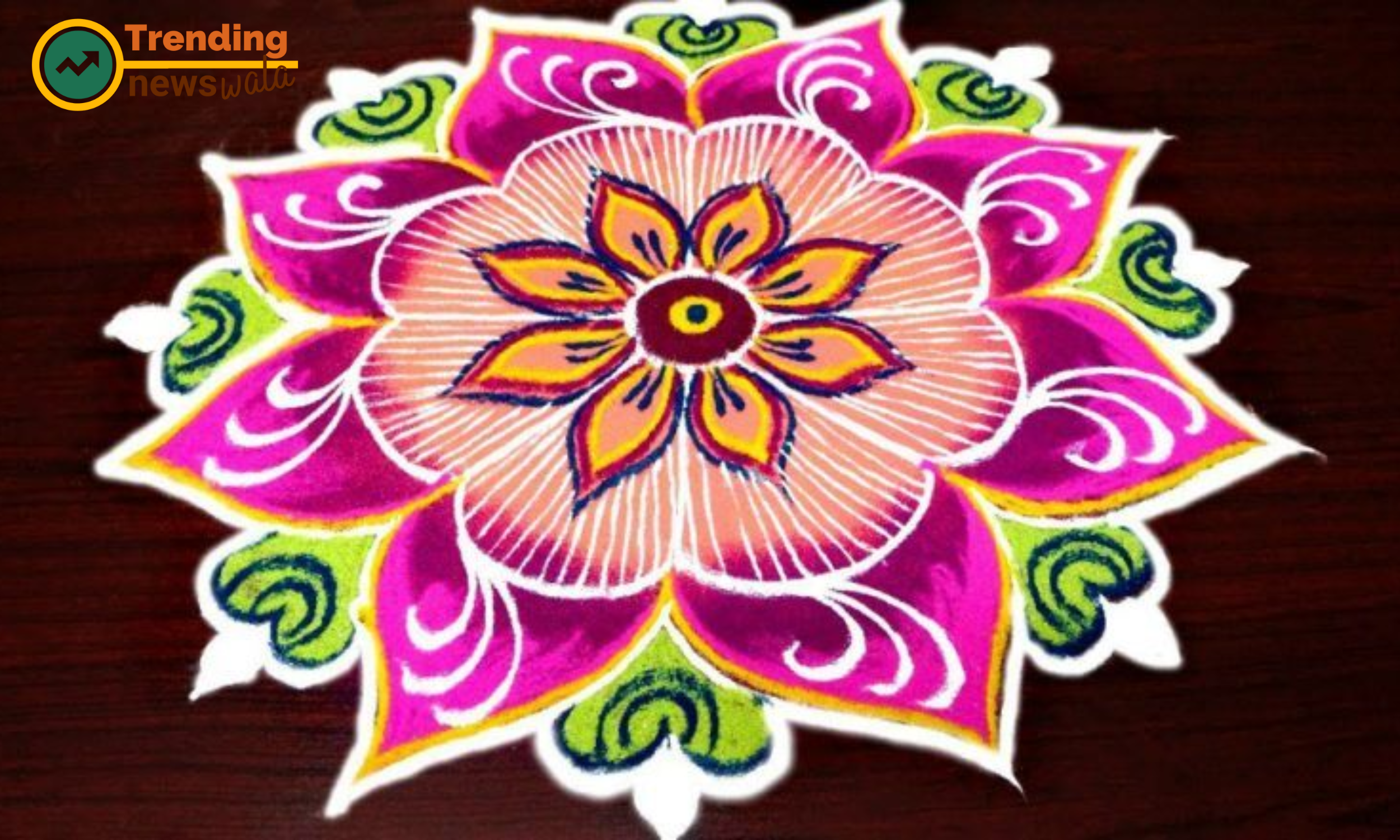
Puthandu Kolam designs They are believed to ward off evil spirits, bring positive energy
Symbolism and Significance:
- Puthandu Kolam designs are not merely decorative patterns but are imbued with symbolism and significance. They are believed to ward off evil spirits, bring positive energy, and invite prosperity and happiness into the household.
- The intricate motifs and geometric shapes used in Kolam designs are inspired by nature, traditional symbols, and cultural motifs, reflecting the rich heritage of Tamil culture.
Materials and Techniques:
- Puthandu Kolam designs are typically created using rice flour, which is finely ground and mixed with water to form a smooth paste. Colored powders, flower petals, or natural dyes may also be used to add vibrancy to the designs.
- Traditional Kolam designs are drawn freehand, with skilled practitioners using their fingers or special tools called "kolam maavu" to create intricate patterns. The designs are often symmetrical and may feature repetitive motifs arranged in a geometric layout.
- Puthandu Kolam designs encompass a wide range of themes and patterns, each with its own significance and symbolism. Common motifs include flowers, birds, animals, geometric shapes, traditional symbols like the sun, moon, and stars, as well as religious symbols such as the lotus, swastika, and conch shell.
- Some popular Puthandu Kolam designs include "Neli Kolam" (line Kolam), "Pulli Kolam" (dot Kolam), "Padi Kolam" (step Kolam), and "Sikku Kolam" (twisted Kolam). Each design has its own unique arrangement of dots and lines, creating visually stunning and intricate patterns on the ground.
- Puthandu Kolam designs may vary depending on the season, festival, or special occasions. During Puthandu, Kolams may feature special motifs like mangoes, sugarcane, and traditional lamps to symbolize abundance, prosperity, and festive cheer.
- Kolam designs may also change with the seasons, with floral motifs and natural elements incorporated into the patterns to reflect the beauty of nature and the changing seasons.
Social and Cultural Importance:
- Puthandu Kolam designs are not only decorative but also hold social and cultural significance in Tamil Nadu. They are often created collaboratively by women in the household, fostering a sense of community and togetherness.
- Kolam-making is considered an art form passed down through generations, with mothers teaching their daughters the traditional techniques and patterns. Kolam competitions and exhibitions are also held during Puthandu celebrations, showcasing the creativity and skill of Kolam artists.
- Also Read :
- Ancient Festivals of India Ganesh Chaturthi
- Ancient Festivals of India Kartik Poornima
- Ancient Festivals of India Bhai Dooj
Puthandu festival decorations
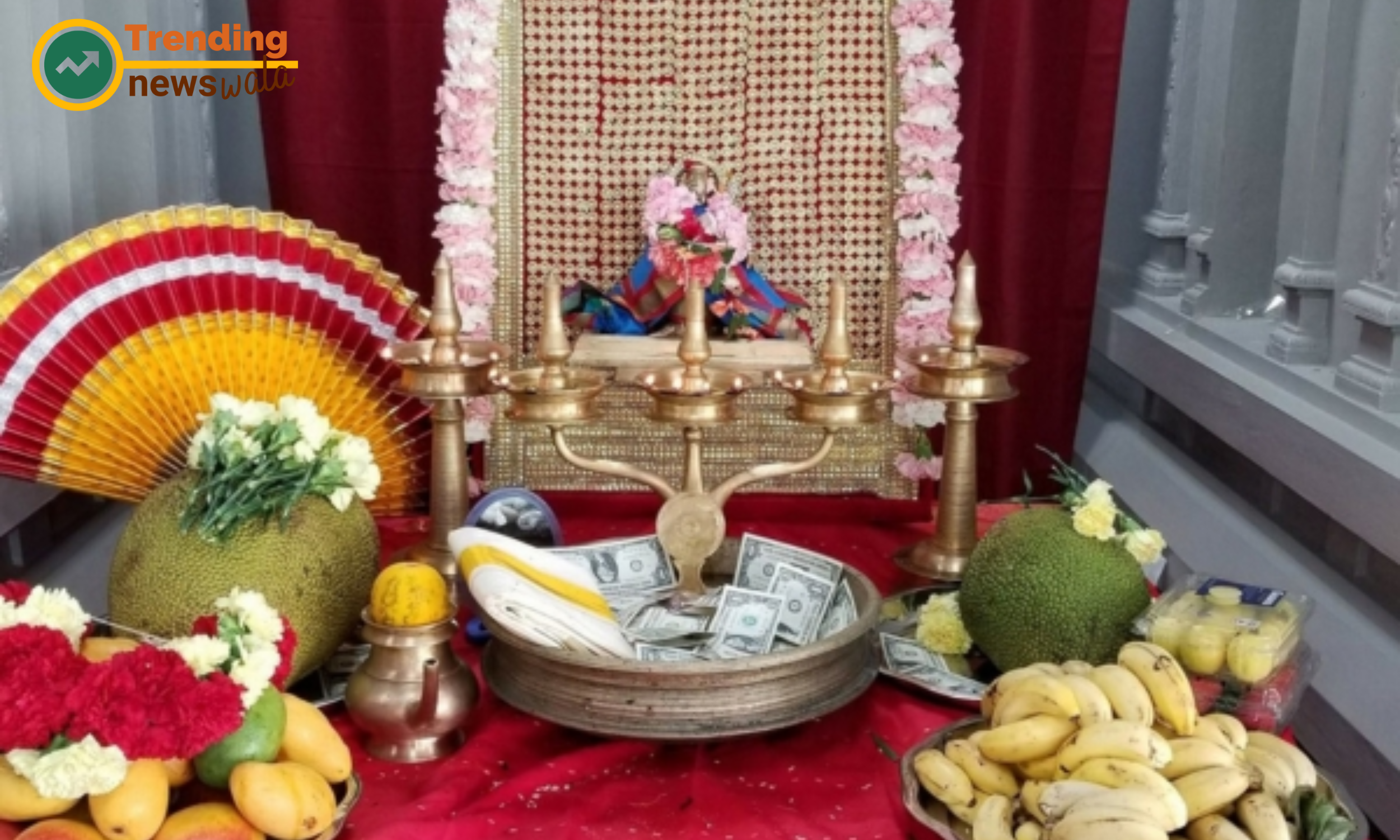
Puthandu festival decorations gid Kolam designs feature geometric shapes, floral motifs, and traditional symbols
- Kolam designs are an integral part of Puthandu festival decorations. These intricate patterns, drawn on the ground using rice flour or colored powders, symbolize prosperity, auspiciousness, and welcome. Kolam designs feature geometric shapes, floral motifs, and traditional symbols, and they are created in front of homes and temples to invite blessings into the household.
Torans and Doorway Decorations:
- Torans, or decorative door hangings, are commonly used to adorn the entrance of homes during Puthandu celebrations. These colorful hangings are made from materials like mango leaves, marigold flowers, coconut fronds, and beads. Torans are believed to ward off evil spirits and bring prosperity and happiness into the home.
- Flowers play a central role in Puthandu festival decorations. Homes and temples are adorned with strings of marigold, jasmine, and other fragrant flowers to create a festive ambiance. Flower garlands are used to decorate doorways, arches, and idols of deities, adding beauty and fragrance to the surroundings.
Mango Leaves and Banana Stems:
- Mango leaves and banana stems are considered auspicious in Tamil culture and are used extensively in Puthandu decorations. Mango leaves are hung above doorways and windows to signify abundance and fertility, while banana stems are used to create decorative arches and rangolis, symbolizing prosperity and growth.
Traditional Lamps and Lanterns:
- Traditional lamps, known as kuthuvilakku or nilavilakku, are lit in homes and temples during Puthandu celebrations. These brass or clay lamps are adorned with intricate designs and filled with oil and wicks, symbolizing the triumph of light over darkness and dispelling negativity.
- Decorative lanterns, known as kandils or akashdeepams, are also hung in homes and streets to add a festive glow to the surroundings. These colorful lanterns are made from paper or cloth and are often adorned with tassels, mirrors, and embellishments.
Rangoli and Floor Decorations:
- In addition to Kolam designs, rangolis and floor decorations are created using colored powders, flower petals, and grains during Puthandu celebrations. These intricate patterns adorn the floors of homes and temples, symbolizing prosperity, welcome, and good fortune.
- Rangolis may feature traditional motifs like peacocks, elephants, lotus flowers, and religious symbols, creating visually stunning displays of artistry and creativity.
Festive Drapes and Fabrics:
- Homes and temples are decorated with colorful drapes, fabrics, and textiles during Puthandu celebrations. Vibrant saris, shawls, and curtains in hues of red, yellow, and green are used to adorn windows, altars, and seating areas, adding a festive touch to the surroundings.
- Idols of deities, especially Lord Ganesha and Goddess Lakshmi, are prominently displayed in homes and temples during Puthandu celebrations. These idols are adorned with flower garlands, sandalwood paste, and decorative clothing, and offerings of fruits, sweets, and incense are made to seek blessings for the New Year.
What is Puthandu?
Puthandu, also known as Tamil New Year, is the first day of the Tamil calendar year. It is celebrated by the Tamil-speaking community in Tamil Nadu, India, and among Tamil diaspora communities worldwide.
When is Puthandu celebrated?
Puthandu typically falls on April 14th or 15th of the Gregorian calendar. The exact date is determined based on the position of the sun and moon relative to the zodiac sign of Mesha (Aries).
What are the customs and traditions associated with Puthandu?
Puthandu celebrations begin with the observation of traditional rituals such as the Puthandu Kanni ritual, where families view auspicious items arranged on a tray to usher in good fortune for the New Year. Special prayers, temple visits, cultural events, and feasting with family and friends are also part of the festivities.
What is the significance of Puthandu Kanni ritual?
The Puthandu Kanni ritual involves viewing a carefully arranged display of auspicious items early in the morning on Puthandu day. It is believed to bring prosperity, happiness, and auspiciousness for the entire year ahead.
What are some traditional dishes prepared during Puthandu?
Puthandu is celebrated with a variety of traditional dishes such as Mango Pachadi, Vegetable Sambar, Vadai, Payasam, Rasam, Puliyodarai, Paruppu Usili, and Sakkarai Pongal. These dishes are prepared and enjoyed with family and friends during festive feasts.
How are homes decorated for Puthandu?
Homes are decorated with colorful Kolam designs drawn on the ground using rice flour or colored powders. Torans, floral decorations, mango leaves, banana stems, traditional lamps, rangolis, and festive drapes are also used to adorn homes and create a festive ambiance.
What are some common Puthandu greetings and wishes?
Popular Puthandu greetings include "Puthandu Vazthukal" (New Year Greetings), "En Iniya Puthandu Nalvazhthukkal" (My Sweet New Year Wishes), and "Anbu Puthandu Vazthukal" (With Love, New Year Greetings). These greetings are exchanged to convey good wishes and blessings for the New Year.
Are there any special cultural events or programs held during Puthandu?
Yes, Puthandu is marked by cultural events, music and dance performances, religious processions, temple festivities, and community gatherings. These events showcase the rich cultural heritage of Tamil Nadu and bring people together to celebrate the New Year in a joyous atmosphere.
Is Puthandu celebrated only in Tamil Nadu?
No, Puthandu is celebrated by Tamil-speaking people worldwide, including in other Indian states like Puducherry, Karnataka, and Kerala, as well as in countries with significant Tamil diaspora populations such as Sri Lanka, Malaysia, Singapore, and Canada.
What is the significance of Puthandu festival?
Puthandu signifies new beginnings, prosperity, and spiritual renewal. It is a time to reflect on the past year, set positive intentions for the future, and celebrate the richness of Tamil culture and tradition with loved ones.












